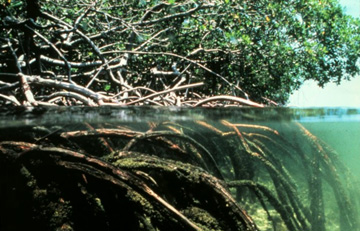Mangrove forests along the world’s coastlines are becoming less common these days, in large part because they keep people away from the ocean. But the forests that are left may serve as a barrier against the fury of Mother Nature by keeping the ocean away from people.
 Mangrove swamp, partly underwater showing the root system. Credit: National Oceanic and Atmospheric Administration
Mangrove swamp, partly underwater showing the root system. Credit: National Oceanic and Atmospheric AdministrationUndisturbed mangrove forests form thick tangles of vegetation. And they serve as habitat for fish, birds, mammals, and other critters. But in many parts of the world, they’ve been stripped away to make room for human development.
That’s not only removing protection for the creatures that inhabit the forests -- it could also be stripping away protection for people who live along the coastline.
A 2011 study, for example, looked at the tsunami that struck coastlines around the Indian Ocean in December 2004. Triggered by a massive earthquake on the ocean floor, the tsunami killed about a quarter-million people -- most of them in Indonesia.
The study found that vegetation along the Indonesian coastline helped boost the chance of survival for residents of towns and villages. The vegetation appeared to slow the advancing waves, giving people a little more time to escape. Overall, the study found that vegetation reduced casualties by about five percent, with natural forests providing a slightly better barrier than rubber-tree plantations or other cultivated plants.
Mangrove forests and other trees can’t block the power of a tsunami. But they just might slow it down a little bit, providing a few extra minutes to escape its fury.

